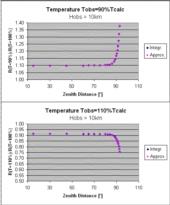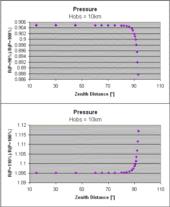
NavList:
A Community Devoted to the Preservation and Practice of Celestial Navigation and Other Methods of Traditional Wayfinding
Re: Refraction at the horizon.
From: Marcel Tschudin
Date: 2008 Mar 19, 01:21 +0200
From: Marcel Tschudin
Date: 2008 Mar 19, 01:21 +0200
George asked > So something is wrong. What might that be? One possibility is a simple > cock-up, in the sunset timing or in its calculation. I mentioned before that the total refraction is 49.9 min arc when using the standard atmosphere and the atmospheric conditions at 00Z of the same day. This value contains the part of the refraction from the horizon to the observer which is 18.9 min arc. So the "terrestrial refraction" seems already to have been higher than the mentioned value. ========================== George comes back on my previous remark > > In an earlier message (4717) Marcel wrote- > > > "I investigated some time ago how the refraction at large zenith distance > depend on changes in temperature and pressure at the observer and found at > that time that those dependencies are quite exponential." > > Marcel, I have searched for some meaning in that sentence, but remain > baffled by it. What on earth does "quite exponential" imply? A naive view is > that the quantity (refractive index - 1), which defines refractive bend, is > almost exactly proportional to air density. That is, to pressure, to the > power +1, and to temperature, to the power -1. Is Marcel saying that isn't > so? What does "quite exponential" mean in this context? > Yes, it means exactly this, that the powers for temperature and pressure aren't any more +1 or -1. Let me explain what I did about one year ago and then left unfinished because other more important work on this subject turned up. At that time I tried to find a transfer function for estimating refraction with a fitted function for (very) high zenith distances, this using the results from calculations done on the standard atmosphere in a model of over 200 layers. The observer was in this model at an altitude of 10km. After having found such a function, I thought that different atmospheric conditions could estimated with it just be scaling, using powers of +1 and -1. I was surprised to find that this was only true for "smaller" ZDs. For larger ZDs, around 90 deg and higher, the functions for the powers would also have to be found by a separate fit. I attach here a few gif files showing the calculated and the fitted values: Ref-ZD.gif: shows refraction as a function of ZD. Ref-Temp.gif: shows how the power for the temperature changes as a function of ZD when changing the temperature to 90% or 110% of the initially calculated one. Ref-Press.gif: shows the same thing for the pressure. Marcel --~--~---------~--~----~------------~-------~--~----~ Navigation List archive: www.fer3.com/arc To post, email NavList@fer3.com To , email NavList-@fer3.com -~----------~----~----~----~------~----~------~--~---









